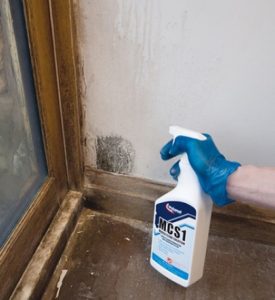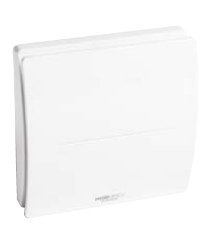
In this post, we will be discussing one of the most common and unwanted forms of damp that might affect your property. Condensation damp tends to occur when there is a high level of relative humidity, which can be caused by many factors including cooking in an improperly ventilated area, drying clothes indoors with inadequate airflow and even changes in temperature. Due to the large range of possible causes, it is important that you employ a specialist surveyor when attempting to tackle any issues with condensation, to ensure that the works carried out will be sufficiently thorough in preventing further condensation damp.
What is condensation?
Condensation occurs when matter changes from a gas into a liquid, we tend to see this in properties when warm air hits a pocket of cooler air, or when warm air comes in to contact with a cold surface. Warm air tends to hold a greater volume of moisture than cold air does, and as such when it comes in to contact with colder surfaces it releases some of that moisture, this is when condensation occurs.
Colder surfaces tend to be those nearest to windows, externally facing walls, and a build-up of moisture in these areas can be a particularly unpleasant situation. Many homeowners are unaware that they are contributing to their condensation problem by simply going about their lives in their home, and because of this, condensation is one the leading causes of damp Different Types of Damp in UK homes.
What damage can condensation cause?
Whilst many simply see condensation as a minor inconvenience, it can soon evolve into a larger issue. If left untreated, condensation tends to lead to mould growth in the affected areas. It is not unheard of for mould growth to penetrate walls and recede into cavities, which if left for a long period of time, can cause structural damage. Whilst that is a worst-case scenario, it is also not uncommon for paint work to start to peel, and for paperwork to start to bubble up, eventually leading to further costs, which will continue to occur if the root cause is left untreated.
Condensation can also lead to damaged personal items and furnishing if left untreated. Mould can, and will grow on practically anything and once it has a foothold it can be very difficult to eradicate. Musty, stagnant smells will continue to linger long after the visible signs have been treated, leaving you with little option but to get rid of the affected item.
The mould itself can also cause health issues, as the spores are airborne and thus inhaled by any occupant of the room. People who suffer from asthma, bronchitis and even tonsillitis, can have their issues triggered when living in a damp, mould infested environment. It is even possible for the damp to a be a cause of skin issues such as eczema and hives. People with weak immune systems will have a hard time fighting off the adverse effects of mould spores in the air, but even those with minimal health issues should seek to address any condensation issues immediately.
How to Manage Condensation
Now that we have discussed the causes and issues that condensation can cause, we will take a look at how you can prevent it. As we touched on earlier in the post, condensation can be caused by excess moisture lingering in the air, so controlling this will be our objective. The key to eliminating moisture in the air is to be consistent in your anti-condensation routine, especially during the colder months.
Wipe down Affected Windows
The windows in your home will more than likely be the first visible indicator of condensation, and they are a good place to start. Whilst this is not technically a preventative measure, it will help to remove some of the moisture from the room, and be effective in helping to prevent mould growth. This should ideally be done every day, first thing in the morning. You can use a kitchen towel or other absorbent cloth to gently wipe away any liquid that has formed on the windowpanes, you should ensure they are as dry as possible.
If mould has started to form you can use a hot soapy cloth to wash down the affected area, which should be disposed of immediately as to not spread spores. The window can then be dried with a separate cloth. It is not advised to brush the area down, as you risk spreading mould spores around your home. Luckily, at LABS we stock a specialist mould eradication kit, which includes a bottle of MCS1 (also sold separately), which works to combat the spread of mould by killing any spores or growths that might have occurred. You can find it in our online shop at https://l-a-b-s.co.uk/product/no-more-damp-mould-treatments/

Attempt to Maintain a Constant Temperature
It is a good idea to set your thermostat, to a low even temperature in order to prevent cold spots from occurring. With fewer cold spots, there will be less of an opportunity for the condensation to form. If the problem is particularly bad, it would be wise to keep the heating on all day, even when you’re not at home in order to keep the condensation at bay.
Ventilation
It is very common for newer windows to already have “trickle vents” installed, however, the majority of older properties will have to be ventilated in order to manage the condensation problem. The recommended process is to ventilate a space in 15 minute periods, for example, when you wake up in the morning, during the process of wiping down your windows, you could open any doors and other windows in order to allow any moisture that has built up overnight, to escape. This will cause the relative humidity of the space to steadily decrease.
It is also important to ventilate whilst you cook or dry clothes, as both of these activities have the potential to create a lot of moisture in the air. It is as simple as opening windows and doors in the space that you intend to do these activities so moisture can escape. Should these preventative measures fail, we can move on to things like installing more air bricks or vents in the property. Positive Input Ventilation is also a great option, which we will discuss later.

Furniture Positioning
In addition to the preventative measures mentioned before it is also advisable to keep items such as sofas, drawers, wardrobes, and cabinets, etc. slightly away from the walls so that air is allowed to circulate behind them. A 5cm gap should be sufficient. It is also advised that you keep furniture away from the external walls altogether if possible. External walls will naturally be cooler than the internal walls, hence allowing for condensation to arise easier.
Insulation
The proper installation of insulation can make a huge difference to the levels of the condensation in your home, especially if cavity walls are present. Another important factor in managing the condensation is the loft insulation and double-glazed windows, both of which will help you maintain a constant temperature throughout your home when installing properly.
Dehumidifying with Positive Input Ventilation Units (PIV’s)
The key component to condensation in the air, is excess moisture, therefore it makes sense to remove as much of it as possible in order to manage the build-up of condensation. A great way to do this is to use a positive input ventilation system, which is an energy efficient method of displacing stale contaminated air and replacing it with fresh filtered air. Fresh air is drawn from outside via the loft space through a filter on the unit and delivered into a central location in your home.
This displaces vapor-laden air, which lowers humidity levels, cures condensation and eradicates mould. The unit runs continuously except when the loft temperature rises above 25°C when the unit will switch off. This is as the hot incoming air would be uncomfortable. When the air temperature falls below 25°C, the unit will switch back on. For more information on these systems, see our shop page at: https://l-a-b-s.co.uk/product/positive-air-vents-heat-recovery-units/

If you know someone with a condensation problem, or if you are a landlord and wish to make your tenant aware of how important it is to prevent condensation build-up, feel free to share this blogpost with them. Or for any other property advice, please give us a call on 0114 2302865 and we will be happy to help!
For more, see our 5 Top Tips for Cellar Conversion

